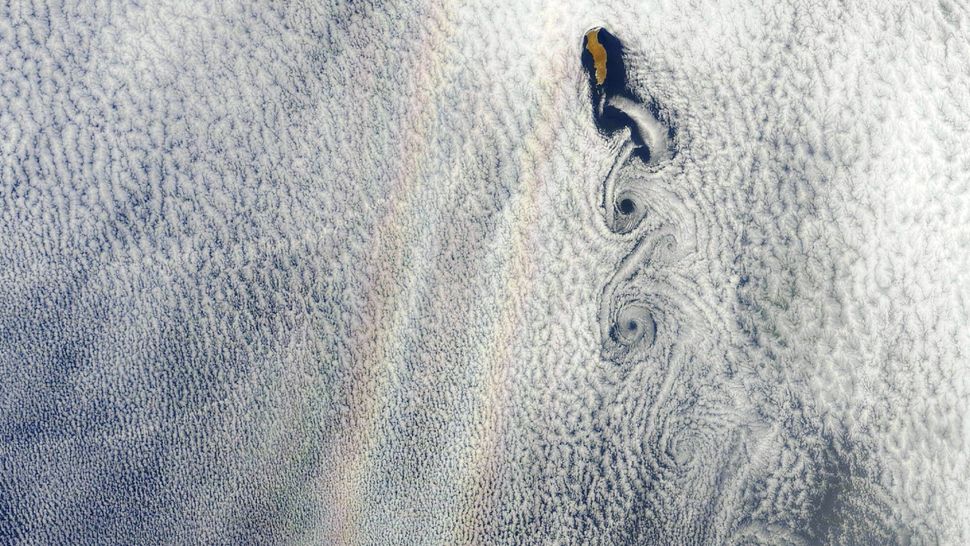Latin America
Related: About this forumEarth from space: Warped 'double rainbow' glory appears next to rare cloud swirls over Mexican island
By Harry Baker
published 1 hour ago
A 2012 satellite photo captured an unusual "double rainbow" glory appearing next to an unconnected chain of rare vortices in the clouds above Mexico's Guadalupe Island.

What looks like a double rainbow but is actually a warped "glory" shines in the sky above Mexico's Guadalupe Island in 2012 as rare Von Kármán vortices swirl away from the landmass. (Image credit: NASA/Terra/MODIS/Jeff Schmaltz)
This 2012 satellite photo shows a unique perspective of a rare, rainbow-like phenomenon, known as a glory, that appeared next to a Mexican island just as the landmass spawned a separate series of equally uncommon cloud vortices.
Glories are multicolor light shows similar to rainbows, with one key difference: While rainbows form via a combination of reflection and refraction when sunlight bounces off falling rain droplets and splits into different wavelengths, glories are created by backward diffraction — when light bounces directly off even smaller water droplets in clouds or mist, according to NASA's Earth Observatory. Because of this, glories only appear exactly opposite the sun, known as the anti-solar point.
This glory appeared adjacent to Guadalupe Island in the Pacific Ocean, around 150 miles (240 km) off the western coast of Mexico, and seemed to stretch for more than 300 miles (480 kilometers). Although there appear to be two distinct glories running parallel to one another, it is a single entity.
In the image, a line of eerily perfect cloud swirls, known as Von Kármán vortices, trail off the island's southernmost point. These swirling structures are formed when clouds get caught up in an airflow that has been disrupted by a tall landmass, most often above an ocean. In this case, the disruption is caused by a volcanic mountain ridge in the north of Guadalupe Island, which rises more than 4,200 feet (1,300 meters) above sea level.
More:
https://www.livescience.com/planet-earth/weather/earth-from-space-warped-double-rainbow-glory-appears-next-to-rare-cloud-swirls-over-mexican-island
~ ~ ~
What Is a Glory?
By
Noel Kirkpatrick
Updated October 30, 2018

Due to its appearance, the glory is sometimes mistaken for a circular rainbow. It just looks like one, however. (Photo: ThaliaTraianou/Wikimedia Commons)
If you've every looked out the window of an airplane and spotted a series of bright colorful rings against the clouds, you've seen a glory.
You probably thought it was an oddly shaped little rainbow, an easy enough mistake to make given that a glory does look like a very compact floating circle of a rainbow, with bright red lines along the outer edge and blue ones at the center of the circle.
However, circular rainbows are entirely phenomenon different from the glory, which is its own unique and special occurrence.
Glories were first scientifically reported in the mid-1730s when a group of European explorers gathered along the Peruvian Andes. The leader of the expedition, French explorer Pierre Bouguer, wrote this about the glory each of the men saw:
"A phenomenon which must be as old as the world, but which no one seems to have observed so far ... A cloud that covered us dissolved itself and let through the rays of the rising sun ... Then each of us saw his shadow projected upon the cloud... The closeness of the shadow allowed all its parts to be distinguished: arms, legs, the head. What seemed most remarkable to us was the appearance of a halo or glory around the head, consisting of three or four small concentric circles, very brightly colored, each of them with the same colors as the primary rainbow, with red outermost ..."
More:
https://www.treehugger.com/what-is-a-glory-4869619
Dale in Laurel MD
(752 posts)but what is that tentacle wearing a shoe just above the upper vortex?